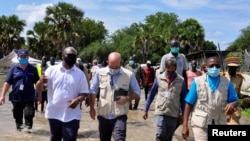The World Food Program reports unprecedented flooding in South Sudan has plunged some 700,000 people into a hunger and livelihoods crisis, made worse by ongoing violence and economic shocks due to COVID-19.
Nearly half of South Sudan is under water. The World Food Program reports entire villages, homes, and farmlands in 36 counties are submerged. It says the situation is particularly dire in Jonglei State, where one-third of the country’s 700,000 flood victims live.
WFP Country Director in South Sudan, Matthew Hollingworth says 85,000 people have been displaced by the flooding, which has disrupted trade routes, damaged crops, killed livestock and submerged houses.
“This flooding crisis is coming on top of a very grim hunger situation in Jonglei where already this year 1.4 million people were suffering from acute and severe hunger in addition to over 300,000 children under five who are acutely malnourished,” Hollingworth said.
Hollingworth says tackling the humanitarian needs of the flood victims is particularly difficult in the midst of increasing violence and COVID 19-related economic and health crises.
This year’s torrential rains began well before the water from last year’s flooding had fully receded. Aid workers fear the flooding is likely to be even more severe when the so-called normal rainy season starts.
Hollingworth says there are very worrying signs of deepening hunger in a country which has seen 31 pockets of famine in the past five years.
“We have yet to get data back to confirm how bad it will be. But I think we all need to prepare ourselves that we must do everything in our power to avoid famine and to avoid the levels of hunger—the catastrophic hunger that we have seen sadly in the past in this country,” Hollingworth said.
WFP currently is providing food aid to 300,000 people. It is scaling up its life-saving operation to support 700,000 flood-affected people who have lost their harvests and livelihoods. The agency is appealing for $58 million for the coming six months.
